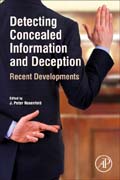
Detecting Concealed Information and Deception: Recent Developments
Rosenfeld, J. Peter
Detecting Concealed Information and Deception assembles in one volume contributions from the world's leading experts on all aspects of concealed information detection. This reference examines an array of different methods-behavioral, verbal interview, and physiological-of detecting concealed information. Chapters from leading legal authorities address how to make use of detected information for present and future legal purposes. With a theoretical and empirical foundation, Information Detection also covers burgeoning new human interviewing techniques, including the highly influential Implicit Association Test among others. Presents research from Concealed Information Test (CIT) studiesExplores the legal implications and admissibility of the CITCovers EEG, event-related brain potentials (ERP), and autonomic detection measuresReviews multiple verbal lie detection toolsDiscusses ocular movements during deception and evasionIdentifies how to perceive malicious intentionsExplores personality dimensions associated with deception including religion, age, and gender INDICE: Section 1 - Background, History, and Theory 1. Physiological Measures in the Detection of Deception and Concealed Information 2. Concealed Information Test: Theoretical Background 3. The External Validity of Studies Examining the Detection of Concealed Knowledge, Using the Concealed Information Test (CIT) 4. Physiological Responses in the Concealed Information Test: A Selective Review in the Light of Recognition and Concealment 5. Field Inventions and Findings of the Concealed Information Test in Japan Section 2 - Neuroscience Applications 6. Effects of Motivational Manipulations on the P300-based Complex Trial Protocol for Concealed Information Detection 7. Detecting Deception and Concealed Information with Neuroimaging Section 3 - Ocular Applications 8. Detecting Concealed Knowledge from Ocular Responses 9. Ocular-Motor Deception Test Section 4 - Behavioral Applications 10. Deception Detection with Behavioral Methods: The Autobiographical Implicit Association Test (aIAT), CIT-RT, Mouse Dynamics and Keystroke Dynamics 11. Challenges for the Application of Reaction Time-based Deception Detection Methods Section 5 - Verbal and Interviewing Applications 12. How to Interview to Elicit Concealed Information: Introducing the Shift-of-Strategy (SoS) Approach 13. Verbal Lie Detection Tools from an Applied Perspective 14. The Applicability of the Verifiability Approach to the Real World Section 6 - Special Issues 15. Personality, Demographic, and Psychophysiological Correlates of People's Self-Assessed Lying Abilities 16. Detecting Concealed Information on a Large Scale: Possibilities and Problems 17. Admissibility and Constitutional Issues of the Concealed Information Test in American Courts: An Update
- ISBN: 978-0-12-812729-2
- Editorial: Academic Press
- Encuadernacion: Rústica
- Páginas: 376
- Fecha Publicación: 01/03/2018
- Nº Volúmenes: 1
- Idioma: Inglés
